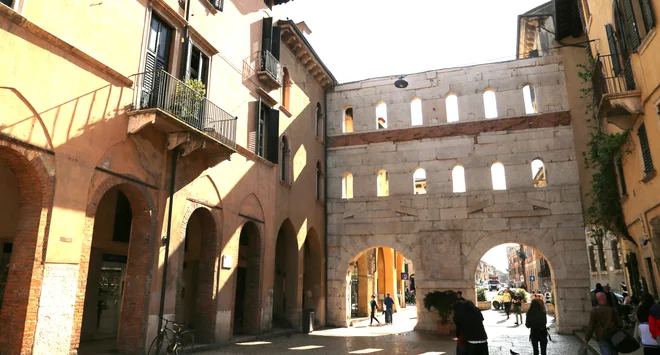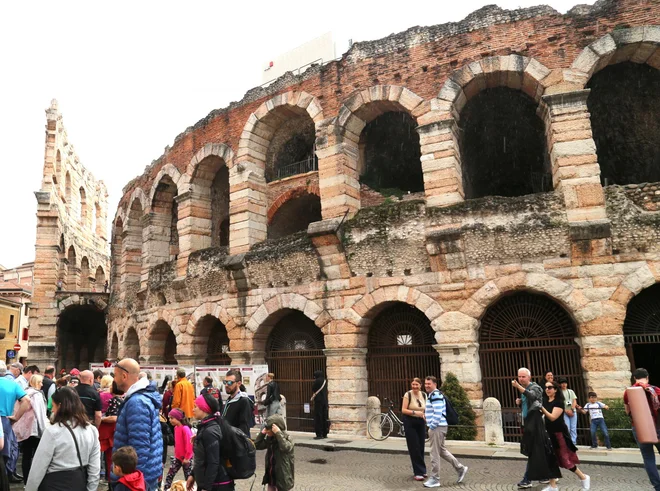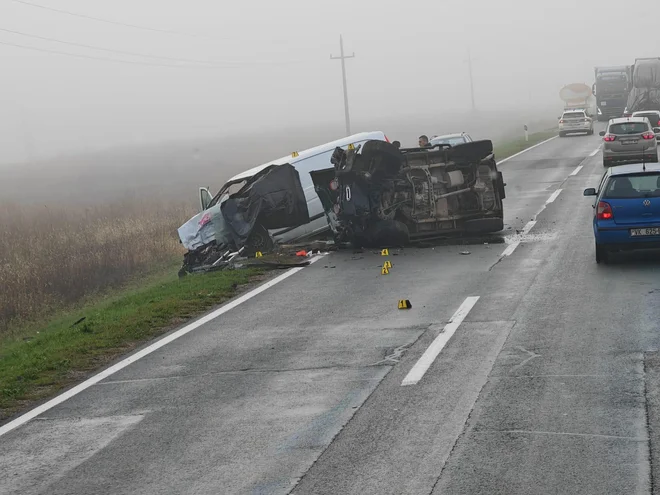The breasts on the statue have no patina, Julia’s breasts glitter because of the touches of hands

The traveler, who arrives in Verona by train, immediately realizes that an old, important place is spread before him. The railway station is just before the fortress walls, through which we reach a wider city center. Verona documents exist more than two millennia.
Most of those who come on foot goes through the old city gates of Porta Nuova, one of the more similar in Verona. Behind them begins the wide Bulvar Corso Porta Nuova, leading to another, older defensive walls around the historic center of the city. The city center lies in an excellent location, on the Peninsula in the form of a language around which the Adiza winds, the second longest Italian river.
The Corso Porta Nuova ends at the Portoni della Bra city gates, behind which is a very large market, Piazza Bra. Here we get to know why Verona is world -famous: on the other side of the market, the famous arena, a relatively well -preserved ancient Roman amphitheater, one of the largest in Italy. The crowds are waiting in line to buy a ticket and see it. Also, many people are stroking around the Bra market, many sit in catering establishments along the arcades of buildings bordering the market on the west side.
One of several old city gates at the entrance to the city center. Photo: Milan Ilic
The multifunction of the ancient amphitheater
The Verona Arena was probably built in 1 century of our counting. Many things have been happening in the past two thousand years, including gladiatorial fights and other spectacles, bullfights (one was also viewed by Napoleon), for centuries the people lived in it, there were warehouses, a prison camp, a shelter from bombing …
Since the mid -19th century, opera performances have been organized in the arena. From this tradition, the now world -renowned Arena di Verona festival developed, a series of opera shows, which are organized in the amphitheater every summer. The festival was formally formed in 1936. The auditorium, which is happy to sing the world’s largest opera stars, can accommodate 30,000 people. The Verona Arena is a scene of many other stage and sporting events-many times there has been the target line of the Giro d’Italia cycling race, the last time in 2022. The closing ceremony of the 2026 Winter Olympic and Paralympic Games, organized by the Milano-Cortina d’Ampezzo duo, will be in this arena.
Charm Shakespeare’s heroines
A more vast observer on the BRA market will not overlook the memorial plaque on the walls not far from the aforementioned city gates dedicated to the second « icon » Verona, Shakespeare’s drama Romeo and Julia. On the board, next to which the artist is a bust, the verses of the third act are carved, Rome’s desperate words after being expelled from Verona. Ivan Cankar, who postponed the tragedy in five acts, have translated them like this:
The world is nowhere like in this masonry,
Elsewhere there are jokes, torment, it’s baking!
Hence the prognan is from the world prognan,
Prognalism, however, is that death.

Capitolare library is the oldest continuous functioning library in the world. Photo: Milan Ilic
Much more people visit a tight yard in Via Cappello Street with Julia’s statue and her alleged house with a balcony. Entering the house (from the late Middle Ages) and on the balcony is charged, but not into the yard. There are often so many visitors that they are waiting in a long row and they are occasionally lowered by security guards. The bust on the statue does not have the patina that can be attributed to time, Julia’s breasts glitter because of the touches of hands, as the belief that the one who touches, especially the right, will have happiness in love. Many in this « pilgrim » place also leave love messages.
The story of Romeo and Julia is literary and has no basis in documented events. Shakespeare really celebrated her, but she is not her original author. As many other works, for example A lot of noise for nothing and Twelfth night, He designed it on the stories of Patra and then Bishop Matteo Bandell, the once most famous European writer of shorter narratives. Bandello died in 1562, two years before Shakespeare’s birth.
However, people like to believe in stories, so many visit them « Julia’s grave » in the wider city center, in the crypt of the church, now the museum complex of San Francesco al Corso, where there used to be a Franciscan monastery. In him, in love hero, she also married. Before the entrance, we again see Shakespeare’s bust, on the wall there is a plate with a part of Rome’s last monologue before death:
Eyes, look
Well on her last time! Roké, take
Hug the Last! Lips, ve duri
life, seal with a kiss
righteous of our contract forever
Death Bowl!
Julia’s sarcophagus is without a lid and empty, but it attracts many visitors. On one of the walls we can read quotes from the 19th century records left by the famous writers, Lord Byron, Heinrich Heine, Charles Dickens … The former monastery complex also has an interesting museum of murals today.

Old building with many older books
In the history of literature, Verona is known, among other things, for the fact that the poet Dante Alighieri has repeatedly lived in it. He first came to the city in 1304 after being sentenced to exile in his native Florence. In Verona, however, they keep books that are much older than Dante’s. The Capitolare library is the oldest documented library in the world. It is not the oldest book building, but the oldest book collection that continues to exist as a library. It is found at the top of the Veronian « language », right next to the cathedral, where it used to be a script. The building is from the first half of the 18th century, but books have been systematically storing for more than half a millennium, since 517. Entry into the library is not free, but it is worth visiting.
The tourist magnet of the city is imposing markets in the Old Town, the Piazza delle Erbe, where there is a larger market, and around the palaces and other old houses, many decorated with murals, and Piazza dei Signori, which is like an outdoor salon. The 84 -meter -high city tower, Torre Dei Lamberti, rises above this market, whose construction began in the second half of the 12th century. Not far away are Arche Scaligeri, the luxuriously decorated tombs of some members of the Scaliger family who have decided to place their sarcophagi on an open public space between the family palace and the church. Interestingly, the only symbol on their coat of arms is a ladder, which also means their surname.
According to this family, it is called the fortified bridge Ponte Scaligero (also Ponte Castelvecchio) on the west side of the foot of the Veron Peninsula. We reach it through the preserved Castelvecchio (Old Castle). His renewal after World War II was designed by the famous architect Carlo Scarpa, according to whose plans the art museum was also placed. Verona played an important role in the rich history of Italian art. The famous painter Veronese was born there and worked for many years, and he was named around the city. The famous Pisanello, named after his native Pisa, created several important images in Verona, as well as no less well -known Andrea Mantegna.

On the other side of Adiza
When we reach the Scaliger Bridge, it is nice to walk along the outer, left bank of Adiza and observe the changing panorama of the city center. At the tip of the peninsula there is Ponte Pietro, a vaulted bridge, the oldest in Verona.
Before the visitors return to the city center, they will not regret that they stayed on the left bank for a while and climb to the Old Roman theater or drove to the San Pietro Castle at the top of the hill, which is the best panoramic view of Stara Verona and its surroundings. For those who like to visit the churches, however, the right title is San Zeno Maggiore, one of the most beautiful works of the sacral Romanesque in northern Italy. The large altar triptyches in it made Mantegna.







